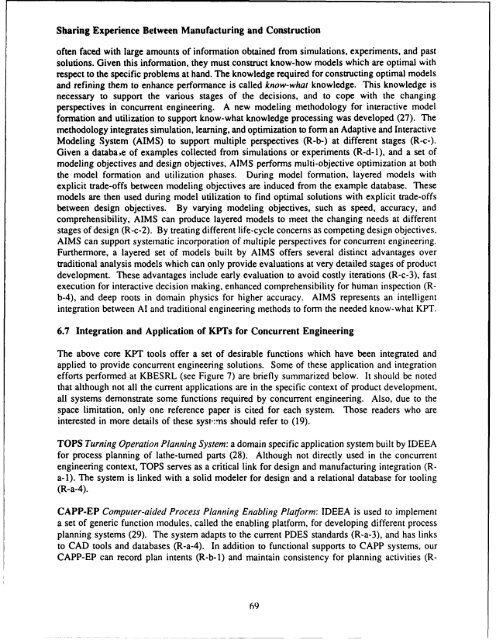Challenges and Opportunities for Innovation in the Public Works ...
Challenges and Opportunities for Innovation in the Public Works ...
Challenges and Opportunities for Innovation in the Public Works ...
You also want an ePaper? Increase the reach of your titles
YUMPU automatically turns print PDFs into web optimized ePapers that Google loves.
Shar<strong>in</strong>g Experience Between Manufactur<strong>in</strong>g <strong>and</strong> Construction<br />
often faced with large amounts of <strong>in</strong><strong>for</strong>mation obta<strong>in</strong>ed from simulations, experiments, <strong>and</strong> past<br />
solutions. Given this <strong>in</strong><strong>for</strong>mation, <strong>the</strong>y must construct know-how models which are optimal with<br />
respect to <strong>the</strong> specific problems at h<strong>and</strong>. The knowledge required <strong>for</strong> construct<strong>in</strong>g optimal models<br />
<strong>and</strong> ref<strong>in</strong><strong>in</strong>g <strong>the</strong>m to enhance per<strong>for</strong>mance is called know-what knowledge. This knowledge is<br />
necessary to support <strong>the</strong> various stages of <strong>the</strong> decisions, <strong>and</strong> to cope with <strong>the</strong> chang<strong>in</strong>g<br />
perspectives <strong>in</strong> concurrent eng<strong>in</strong>eer<strong>in</strong>g. A new model<strong>in</strong>g methodology <strong>for</strong> <strong>in</strong>teractive model<br />
<strong>for</strong>mation <strong>and</strong> utilization to support know-what knowledge process<strong>in</strong>g was developed (27). The<br />
methodology <strong>in</strong>tegrates simulation, learn<strong>in</strong>g, <strong>and</strong> optimization to <strong>for</strong>m an Adaptive <strong>and</strong> Interactive<br />
Model<strong>in</strong>g System (AIMS) to support multiple perspectives (R-b-) at different stages (R-c-).<br />
Given a databa,e of examples collected from simulations or experiments (R-d-l), <strong>and</strong> a set of<br />
model<strong>in</strong>g objectives <strong>and</strong> design objectives, AIMS per<strong>for</strong>ms multi-objective optimization at both<br />
<strong>the</strong> model <strong>for</strong>mation <strong>and</strong> utilization phases. Dur<strong>in</strong>g model <strong>for</strong>mation, layered models with<br />
explicit trade-offs between model<strong>in</strong>g objectives are <strong>in</strong>duced from <strong>the</strong> example database. These<br />
models are <strong>the</strong>n used dur<strong>in</strong>g model utilization to f<strong>in</strong>d optimal solutions with explicit trade-offs<br />
between design objectives. By vary<strong>in</strong>g model<strong>in</strong>g objectives, such as speed, accuracy, <strong>and</strong><br />
comprehensibility, AIMS can produce layered models to meet <strong>the</strong> chang<strong>in</strong>g needs at different<br />
stages of design (R-c-2). By treat<strong>in</strong>g different life-cycle concerns as compet<strong>in</strong>g design objectives.<br />
AIMS can support systematic <strong>in</strong>corporation of multiple perspectives <strong>for</strong> concurrent eng<strong>in</strong>eer<strong>in</strong>g.<br />
Fur<strong>the</strong>rmore, a layered set of models built by AIMS offers several dist<strong>in</strong>ct advantages over<br />
traditional analysis models which can only provide evaluations at very detailed stages of product<br />
development. These advantages <strong>in</strong>clude early evaluation to avoid costly iterations (R-c-3), fast<br />
execution <strong>for</strong> <strong>in</strong>teractive decision mak<strong>in</strong>g, enhanced comprehensibility <strong>for</strong> human <strong>in</strong>spection (Rb-4),<br />
<strong>and</strong> deep roots <strong>in</strong> doma<strong>in</strong> physics <strong>for</strong> higher accuracy. AIMS represents an <strong>in</strong>telligent<br />
<strong>in</strong>tegration between Al <strong>and</strong> traditional eng<strong>in</strong>eer<strong>in</strong>g methods to <strong>for</strong>m <strong>the</strong> needed know-what KPT.<br />
6.7 Integration <strong>and</strong> Application of KPTs <strong>for</strong> Concurrent Eng<strong>in</strong>eer<strong>in</strong>g<br />
The above core KPT tools offer a set of desirable functions which have been <strong>in</strong>tegrated <strong>and</strong><br />
applied to provide concurrent eng<strong>in</strong>eer<strong>in</strong>g solutions. Some of <strong>the</strong>se application <strong>and</strong> <strong>in</strong>tegration<br />
ef<strong>for</strong>ts per<strong>for</strong>med at KBESRL (see Figure 7) are briefly summarized below. It should be noted<br />
that although not all <strong>the</strong> current applications are <strong>in</strong> <strong>the</strong> specific context of product development,<br />
all systems demonstrate some functions required by concurrent eng<strong>in</strong>eer<strong>in</strong>g. Also, due to <strong>the</strong><br />
space limitation, only one reference paper is cited <strong>for</strong> each system. Those readers who are<br />
<strong>in</strong>terested <strong>in</strong> more details of <strong>the</strong>se syst,-rns should refer to (19).<br />
TOPS Turn<strong>in</strong>g Operation Plann<strong>in</strong>g System: a doma<strong>in</strong> specific application system built by IDEEA<br />
<strong>for</strong> process plann<strong>in</strong>g of la<strong>the</strong>-turned parts (28). Although not directly used <strong>in</strong> <strong>the</strong> concurrent<br />
eng<strong>in</strong>eer<strong>in</strong>g context, TOPS serves as a critical l<strong>in</strong>k <strong>for</strong> design <strong>and</strong> manufactur<strong>in</strong>g <strong>in</strong>tegration (Ra-I).<br />
The system is l<strong>in</strong>ked with a solid modeler <strong>for</strong> design <strong>and</strong> a relational database <strong>for</strong> tool<strong>in</strong>g<br />
(R-a-4).<br />
CAPP-EP Computer-aided Process Plann<strong>in</strong>g Enabl<strong>in</strong>g Plat<strong>for</strong>m: IDEEA is used to implement<br />
a set of generic function modules, called <strong>the</strong> enabl<strong>in</strong>g plat<strong>for</strong>m, <strong>for</strong> develop<strong>in</strong>g different process<br />
plann<strong>in</strong>g systems (29). The system adapts to <strong>the</strong> current PDES st<strong>and</strong>ards (R-a-3), <strong>and</strong> has l<strong>in</strong>ks<br />
to CAD tools <strong>and</strong> databases (R-a-4). In addition to functional supports to CAPP systems, our<br />
CAPP-EP can record plan <strong>in</strong>tents (R-b-1) <strong>and</strong> ma<strong>in</strong>ta<strong>in</strong> consistency <strong>for</strong> plann<strong>in</strong>g activities (R-<br />
69







